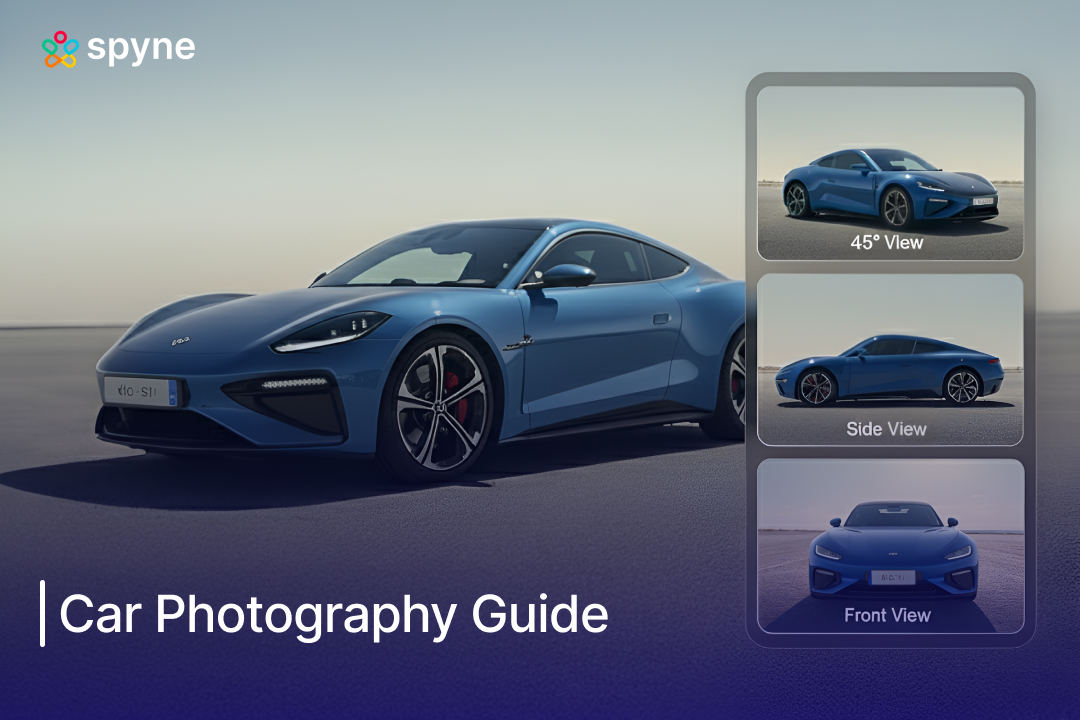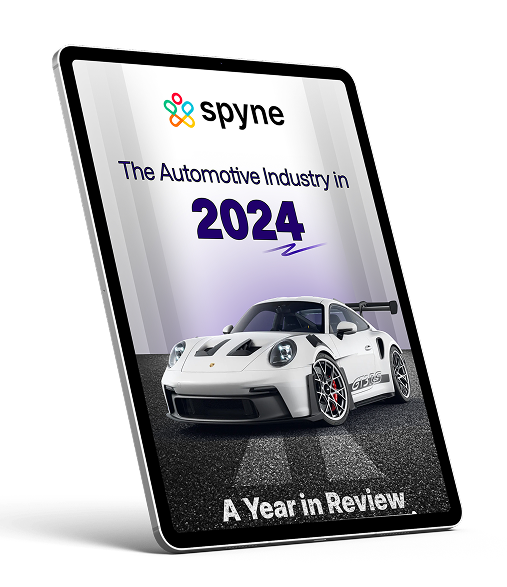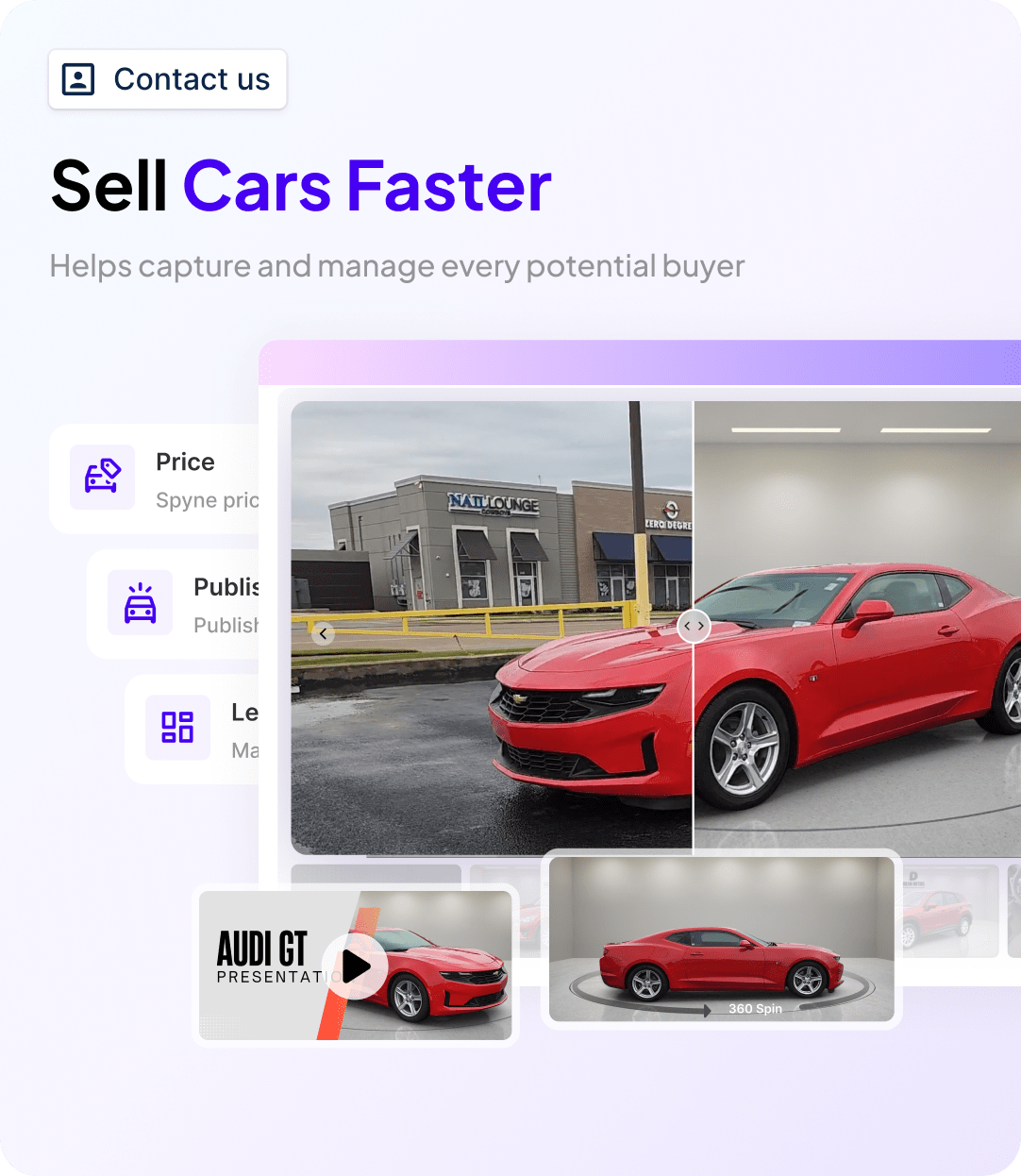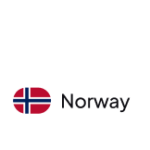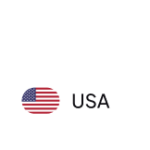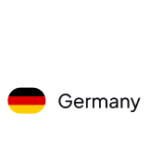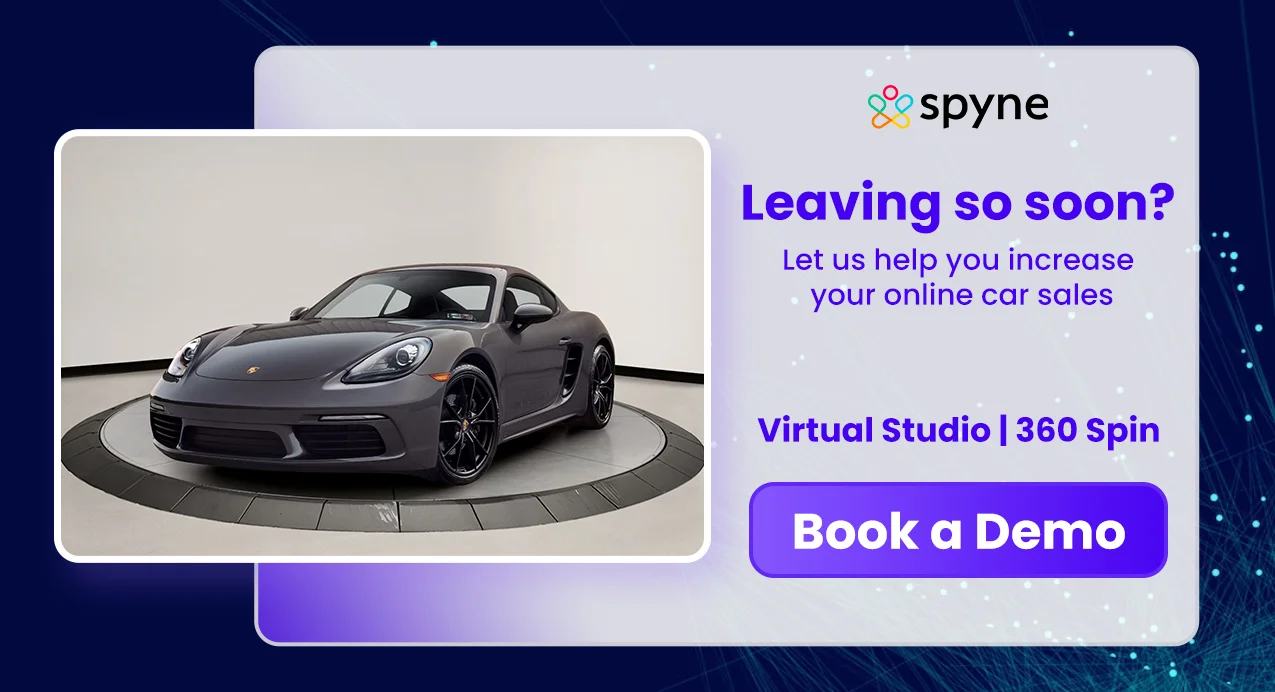In the automotive market today, the battle for attention begins long before a buyer visits a showroom. Shoppers scroll through endless online listings, and in those fleeting seconds, visuals make or break their interest. In fact, 95% of vehicle buyers use digital sources to begin their journey, making car photography the sales process itself.
Dealerships know they need images that feel like magazine covers, all bright, engaging, and exuding professionalism, much like the Acura TLX spread in Motor Trend. But producing photography of this caliber comes at a steep cost. Behind the curtain are expansive setups, commercial photographers charging $800 to $1,500 an hour, and post-production timelines that delay campaigns by days. The results may be dazzling, yet the process drains marketing budgets and stretches resources thin.
The challenge is clear: dealerships need the polish of studio-grade imagery without the burden of manual photography set ups. On the other side of the picture, advances in AI are reshaping how cars are photographed, offering scalable alternatives that deliver speed, quality, and affordability.
This car photography guide walks you through techniques and strategies that enable car dealerships to overcome these barriers. At the same time, it gently nudges dealerships toward exploring emerging AI solutions shaping modern car photography
What is Car Photography?
Car photography is the practice of showcasing a vehicle in its best light, both technically and aesthetically. The aim is to create images that elevate the vehicle beyond a simple record, highlighting its design, craftsmanship, and character. Professionals in this field achieve this through controlled lighting, deliberate angles, uncluttered backdrops, and precise post-editing, turning each photo into a visual statement that connects with its viewers.
Use Case: It serves purposes like marketing campaigns, sales listings, editorial features, and personal showcases.
A pre-owned SUV, for instance, can be presented online with a series of shots like wide exterior angles to show its stance, close-ups of the dashboard and infotainment system, or even a dynamic ¾ view that conveys movement. Done right, these images give potential buyers a chance to “experience” the car before stepping into the showroom.
As one dealer put it, “Good car photography reduces questions. The calls are more about features, not doubts, because good car images already answer the basics.” This underscores why clear, high-quality visuals for car dealership photography are indispensable.
Different Categories of Car Photography
Every photo of a car has a story to tell but not all those stories are the same. A sleek ad campaign, an artistic showcase, a sales listing, or a simple record all demand different photographic styles. By understanding these categories, businesses and creators can ensure their images not only look good but also serve the exact purpose they’re meant for.
1. Commercial Car Photography
Commercial car photoshoots are all about producing campaign-ready images that help dealerships, OEMs and agencies promote vehicles through ads, brochures, and digital campaigns. What sets it apart is the combination of high production value (specialized lighting, controlled environments, and professional retouching) with storytelling.
For example, a sports car might be captured on a racetrack with motion blur to emphasize speed, while a family SUV could be photographed in a suburban driveway to highlight practicality and lifestyle appeal.
Key aspects of commercial car photography include:
- Campaign-focused planning: Every image supports a specific message or launch.
- High-end production: Studio setups, location scouting, models, and props.
- Creative direction: Blending lifestyle elements to reinforce brand values.
- Polished outputs: Optimized for billboards, websites, social ads, and print.
2. Creative Car Photography
Creative car photography focuses on capturing vehicles in unique, artistic, and unexpected ways that go beyond traditional sales imagery. Instead of simply showcasing features, it highlights mood, personality, and emotion, turning cars into visual stories or pieces of art.
For instance, a classic car might be shot against neon city lights for a retro-futuristic vibe, or an electric vehicle could be framed in a minimalist environment to emphasize innovation and modern design.
Key aspects of creative car photography include:
- Artistic experimentation: Using dramatic lighting, reflections, and unconventional angles.
- Concept-driven shoots: Aligning visuals with abstract themes, moods, or cultural trends.
- Play with environments: Ranges from gritty urban streets to surreal landscapes.
- Stylized editing: heavy emphasis on color grading, composition, and post-production effects.
3. Sales-Focused Car Photography
Sales-focused car photography is designed with one clear objective, converting shoppers into buyers. Unlike commercial or creative photography, which emphasize storytelling or artistry, this approach prioritizes clarity, accuracy, and consistency to help customers evaluate vehicles quickly and confidently.
For example, an online car listing will often feature high-resolution, well-lit images that show every angle of the vehicle, its interior, and key details like wheels, dashboards, or storage space, removing uncertainty for potential buyers.
Key aspects of sales-focused car photography include:
- Detail-driven imagery: Clear shots of interiors, exteriors, and features.
- Consistency at scale: Uniform backgrounds, lighting, and framing across listings.
- Buyer psychology: Emphasizing trust, transparency, and value.
- Platform optimisation: Tailored outputs for dealership websites, marketplaces, and classifieds.
4. Documentation Photography
Documentation photography is the most straightforward form of car photography, created primarily for record-keeping, verification, and compliance rather than marketing or aesthetics. It focuses on accuracy, neutrality, and completeness to ensure that every important detail of a vehicle is clearly visible and properly archived.
Let’s put it this way, insurance companies after an accident will require full-angle shots, rental companies document vehicles before and after handover, and dealerships capture inventory records for internal use.
Key aspects of documentation photography include:
- Objective imagery: Minimal editing, neutral lighting, and standard angles.
- Complete coverage: Capturing VIN number decoder, odometers, and all visible panels.
- Functional purpose: Supporting insurance claims, inspections, or audits.
- Standardized approach: Ensuring images follow guidelines for legal or operational use.
Anatomy of a Perfect Car Shot
Once the purpose of your photography is defined, the next step is execution, choosing the right angles, lighting, and composition that bring vehicles to life.
To answer some frequently asked questions like: “Which angles actually influence purchase decisions?” and “How do lighting and composition impact ROI?” Here’s a detailed car photography guide:
1. Must-Have Angles
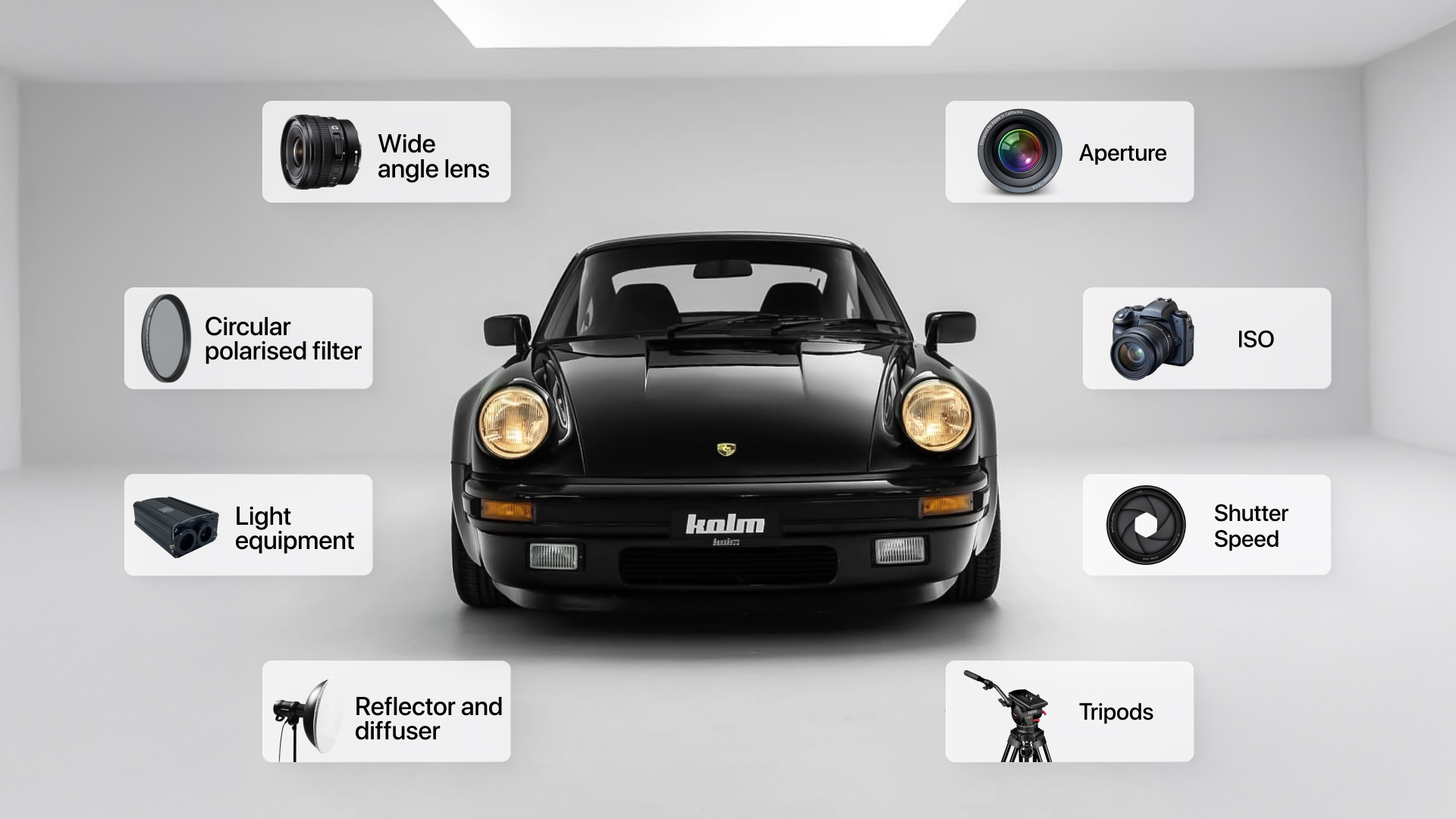
- ¾ Front (Hero Shot): The classic establishing angle, highlighting grille, headlights, and stance
- ¾ Rear: Complements the hero shot by showcasing taillights, rear design, and body lines.
- Full Profile/Side: Clean shot of the entire length, showing proportions, doors, and wheelbase.
- Front Head-On: Emphasizes the grill, headlights, and brand identity.
- Rear Head-On: Captures tailgate, taillights, exhaust, and bumper clearly.
- Interior (Cockpit View): From the back seat, showing dashboard, steering, and infotainment.
- Front Seats Close-Up: Focused view of upholstery, stitching, and comfort.
- Rear Seats View: Highlights passenger space and legroom.
- Trunk/Cargo Space: Open trunk shot with or without seats folded down.
- Dashboard & Infotainment System: Clear display of screens, controls, and technology.
- Wheel Close-Ups: Front and rear wheels, showing design and condition.
- Badges & Branding: Logos, trims, and special edition markers.
- Headlights & Taillights (Detail): Sharp close-ups to show condition and design.
- VIN Plate & Odometer: Documentation shots for transparency and compliance.
- Condition/Damage Shots: Scratches, dents, or wear areas (honest and trust-building).
- Roof/Sunroof: Especially important if panoramic or convertible features exist.
2. Lighting Principles
- Natural Light: Ideal for realistic colors and reflections; shoot in soft morning/evening light to avoid harsh shadows.
- Studio Lighting: Offers uniformity, essential for bulk inventory or high-end vehicles; eliminates inconsistencies across multiple cars.
- Hybrid Approach: Combine natural + studio or use AI-enhanced lighting to scale visually consistent images.
3. Background Choices
- Neutral/White Backgrounds: Emphasize the car; perfect for marketplaces and classified listings.
- Lifestyle/Outdoor Settings: Showcase aspirational ownership scenarios; can increase click-through rates by up to 30%.
- AI-Enhanced Backgrounds: Replace or standardize backgrounds across hundreds of listings efficiently, maintaining high-quality perception at lower costs.
4. Composition Rules
- Framing: Keep the vehicle centered and proportional; avoid awkward cropping.
- Reflections & Distractions: Minimize mirrors, glass reflections, or cluttered backgrounds.
- Proportions: Maintain accurate perspective; wide-angle lenses can exaggerate size if misused.
Styles & Creative Approaches in Car Photography
Understanding the style and approach to car photography is critical for dealerships and automotive businesses. Each style serves a strategic purpose, whether driving engagement, enhancing brand perception, or optimizing inventory presentation.
1. Outdoor/Lifestyle Shoots
- Showcase vehicles in real-world contexts, urban streets, scenic routes, or premium residential areas.
- Effective for conveying aspirational ownership; buyers can imagine themselves using the car in daily life.
- Research shows lifestyle images can increase listing engagement by up to 30%, compared to standard neutral backgrounds.
- Requires consideration of weather, sunlight direction, and reflections; timing shots during golden hour (early morning or late afternoon) yields the most appealing natural light.
2. Studio Shoots with Controlled Lighting
- Offers complete control over lighting, reflections, and color accuracy.
- Ideal for bulk inventory or high-value vehicles where uniformity is essential.
- Using softboxes, diffusers, and LED panels ensures that shadows are minimized and paint finishes are accurately represented.
- Controlled lighting reduces post-production editing time by up to 50%, saving both cost and labor for high-volume dealerships.
3. Motion Photography (Rolling Shots / Panning)
- Captures the vehicle in motion to convey performance, speed, and dynamism.
- Requires fast shutter speeds (1/500+ for sharp panning; 1/100–1/250 for creative motion blur).
- Engages buyers looking for sport or premium vehicles; listings with motion shots often stand out on social feeds, increasing organic reach.
- Best paired with stabilized cameras or gimbals to reduce blur and maintain sharp focus.
4. Night Shoots with Light Painting or Dramatic Tones
- Adds a luxury or cinematic feel, enhancing perceived vehicle value.
- Techniques include light painting, external LED illumination, and controlled long exposures.
- Night photography requires careful attention to ISO (100–400), shutter speed (1–10 seconds for light trails), and tripod stability.
- Effective for premium models or marketing campaigns where visual differentiation is key.
5. Virtual & AI-Aided Compositions
- Emerging as a cost-effective and scalable alternative to manual photography set-ups.
- AI can standardize backgrounds, enhance lighting, remove reflections, and even generate multiple angles from a single capture.
- Reduces per-car photography costs by up to 70%, while maintaining consistent professional quality across hundreds of listings.
- Enables rapid bulk uploads, ensuring inventory turnover isn’t slowed by production bottlenecks.
Essential Car Photography Tools
Professional car photography relies on the right combination of hardware, software, and workflow to produce high-quality, consistent images that accelerate sales. Understanding the tools available helps dealerships make informed investment decisions.
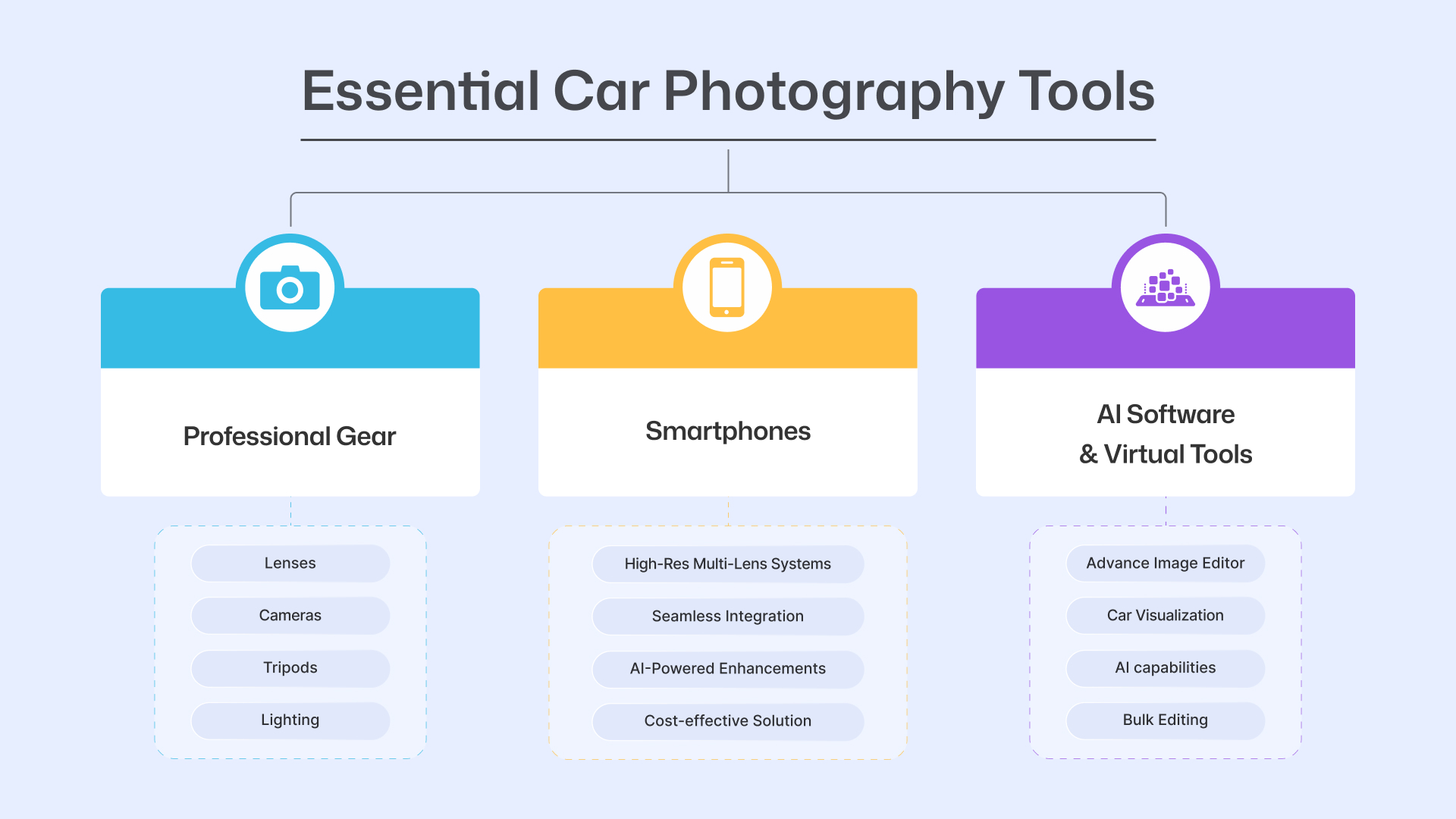
1. Professional Gear
High-end cameras and specialised lenses capture sharp exteriors and subtle design details that smartphones still struggle to replicate. When paired with professional tripods and lighting setups, dealerships and photographers gain the ability to create consistent, brand-defining visuals that command buyer attention in saturated marketplaces.
- Cameras: DSLRs and mirrorless systems remain the gold standard. Full-frame sensors capture dynamic range, detail, and color accuracy essential for showcasing vehicle finishes.
- Lenses: Wide-angle (16–35mm) for full-car shots; prime (50–85mm) for crisp detail isolation. Apertures f/2.8–f/8 balance background blur with sharpness.
- Tripods: Critical for HDR, night shots, and bulk inventory consistency, stabilising images across hundreds of listings.
- Lighting: Softboxes, diffusers, and LED panels reduce reflections and harsh shadows. Controlled lighting can cut post-production work by up to 50%.
2. Smartphones for Car Photography
Smartphones have evolved into powerful tools that can deliver dealership-ready visuals without the need for bulky gear. Their portability, speed, and increasingly advanced cameras make them an accessible choice for everyday use. With the right techniques, mobile devices can rival entry-level professional setups.
- High-Res Multi-Lens Systems: Capture wide angles and close details with DSLR-like sharpness and clarity.
- AI-Powered Enhancements: Built-in HDR, portrait, and night modes optimize photos instantly with minimal effort.
- Cost-Effective Solution: Deliver professional-quality images at scale without investing in expensive photography equipment.
- Seamless Integration: Direct uploads to AI platforms enable background removal, reflection cleanup, and 360° spins with minimal effort.
3. AI Software & Virtual Tools
AI has redefined automotive photography by delivering studio-quality results at scale, without the high costs or long turnaround times of traditional methods. These tools streamline every stage of the visual pipeline, ensuring dealerships can create professional, consistent imagery across large inventories.
- Background Removal & Replacement: Standardises listing visuals, creating clean, distraction-free images that elevate brand perception.
- Reflection Cleanup & Enhancement: Corrects glass, trim, and paint reflections for accurate representation, building buyer trust.
- 360 Spins & Virtual Showrooms: Interactive car tours increase online engagement by up to 50%, helping buyers explore vehicles before stepping onto the lot.
- Bulk Image Processing: AI automation cuts per-car photography costs by up to 70% while delivering ready-to-publish, studio-quality results across hundreds of vehicles.
Car Photography Across Industries
What once lived in magazines and forums, car photography now fuels the backbone of modern automotive commerce and operations. High-quality images have a proven impact: studies show that listings with professional photos get 48% more clicks and sell up to 32% faster than those with amateur images, highlighting the value of investing in visuals.
Businesses across sectors rely on visuals not for the beholder’s eyes, but as proof, persuasion, and performance. Let’s look at how different sectors put car photography to work.
1. Sales & Marketplaces
Photography in car sales is all about building trust and boosting conversions. With 90% of car buyers researching online before visiting a dealership, high-quality images often form the first impression and determine whether a buyer engages or scrolls past. Clear, consistent visuals when paired with effective digital merchandising techniques help customers feel confident about buying online, often replacing the physical showroom experience.
How It’s Used
- Builds buyer confidence by showing every angle of the vehicle.
- Standardizes listings across dealerships and marketplaces for consistency.
- Highlights key features and creates a competitive edge.
Use Case
- Vehicle Listings: Multi-angle shots simulating in-person inspection.
- Conversion Boost: Professional photos lead to higher click-through rates and longer engagement on Vehicle Detail Pages (VDPs).
- Marketplace Standards: Neutral backgrounds and guideline compliance.
- Dealer Branding: Helps dealerships stand out in crowded marketplaces.
2. OEMs & Launches
For automakers, photography is more than a showcase, it’s storytelling. As industry experts note, “Establishing the imagery of the car is more important than the features,” highlighting how compelling visuals shape perception, evoke aspiration, and define a brand’s identity. Every shot communicates design, lifestyle, and emotion, making the car not just a product but an experience.
How It’s Used
- Shapes customer perception through high-impact visuals.
- Builds emotional connections with aspirational storytelling.
- Supports product launches, campaigns, and promotional content across print, digital, and outdoor media.
Use Case
- Campaign Launches: Hero shots for billboards, digital ads, and TVCs.
- Product Catalogs: High-resolution images for brochures and websites.
- Brand Positioning: Lifestyle photography tailored to luxury, sporty, or eco-friendly personas.
- Production Techniques: Studio shoots, CGI integration, and post-production polish.
3. Insurance & Documentation
In the insurance industry, photography serves as trusted evidence. Precise, standardized images reduce disputes, accelerate claim processing, and provide an irrefutable record of a vehicle’s condition, ensuring both transparency and accountability in every transaction.
How It’s Used
- Documents baseline vehicle condition at policy issuance.
- Provides visual proof for claims assessment.
- Enhances transparency and fraud prevention with timestamped, geotagged, or AI-verified images.
Use Case
- Policy Onboarding: Standardized exterior, interior, VIN, and odometer shots.
- Claims Verification: Before-and-after accident images streamline processing.
- Fraud Prevention: Metadata and standardized protocols ensure authenticity.
- Standardized Protocols: Prescribed angles for uniform documentation.
4. Creators & Enthusiasts
For creators and car enthusiasts, photography is an art form and a medium of self-expression. Cars become living canvases for storytelling, lifestyle imagery, and community engagement, allowing photographers to capture emotion, personality, and creativity beyond commercial purposes.
How It’s Used
- Expresses personal style and creativity.
- Fuels social media and online communities.
- Builds portfolios for aspiring automotive photographers.
Use Case
- Social Media Content: Instagram reels, TikTok videos, and YouTube features.
- Events & Meets: Coverage of rallies, shows, and club gatherings.
- Portfolio Development: Showcase technical and artistic skills.
- Creative Techniques: Drone shots, rolling shots, cinematic edits, and stylized post-production.
How Can Car Dealerships Reduce Photography Costs?
One of the most significant pressures facing dealerships today lies in the escalating cost of car merchandising, with photography at the center of this challenge. High-quality visuals are no longer optional; they are a prerequisite for attracting and converting online buyers. Yet, relying on external photographers often places a considerable strain on operating budgets.
Rates vary widely depending on skill and specialisation, and while the quality may improve with experience, so too does the cost, creating an ongoing tension between consistency, scale, and financial viability.
Here is a estimated car photography price list, ranging from beginner to pro.
| Photographer Level | Per Day | Per Hour |
| Beginner Photographers | Up to $1080 | Up to $50 |
| Amateur Photographers | $540 – $2160 | $25 – $100 |
| Intern Photographers | $1080 – $2160+ | $50 – $100+ |
| Semi-Professional Photographers | $1620 – $3240+ | $75 – $150+ |
| Professional Photographers | $2160 – $6480+ | $100 – $300+ |
| Top-Class Professional Photographers | $5400 – $10800+ | $250 – $500+ |
For dealerships managing hundreds of vehicles monthly, these rates quickly translate into thousands of dollars in recurring costs. The result is a constant trade-off between quality and affordability, making it difficult to scale photography workflows without stretching budgets.
The solution to your expensive photoshoot is Spyne’s auto dealership photography, editing, and publishing software.
Where does Spyne help you?
- Up to 75% lower cost: AI eliminates the need for expensive studios, cameras, and professional photographers.
- 80% faster listings: What usually takes days with manual editing and uploads happens in minutes.
- 10× efficiency in workflows: No back-and-forth with photographers or editors; capture, edit, and publish instantly.
- Zero dependency on external teams: Staff with a smartphone can create showroom-ready images without specialized training.
- 95% reduction in editing time: AI handles background removal, shadow correction, and license plate masking automatically.
- Consistent branding across the lot: Every image follows the same visual style, no matter who clicks it.
- A scalable option: No matter what the lot size is, 10 cars or 1,000, the output always remains consistent, uniform and fast.
- Always-on availability: Unlike manual shoots tied to schedules and weather, Spyne lets dealers shoot anytime, anywhere.
- Higher buyer satisfaction with color options: Shoppers often drop off when their preferred color isn’t available. Spyne’s AI color changer lets car dealers showcase cars in user-preferred shades instantly, boosting engagement and reducing lost leads.
How Spyne is Changing the Car Dealership Photography?
Now that we’ve talked about the cost factor, here’s how Spyne’s car photography studio is designed to simplify and scale dealership photography while preserving the professional quality that car buyers demand. Below are the key capabilities, with specific use cases and outcomes.
Virtual Car Photography Studio
Spyne’s AI-powered car photo editor provides dealerships and marketplaces with a complete suite of tools to make raw vehicle images ready for listings in just a few clicks. Each functionality is designed to simplify editing to keep results consistent, professional, and market-ready:
- Advanced Photo Editing: Go beyond simple background removal with 100+ custom car background removal tool, shadow and reflection correction, retouching, clean-up, number plate blur tool, and branded templates to ensure every image looks professional and on-brand.
- Car Visualization Tools: Let buyers imagine endless possibilities with interactive tools like car colour changer tool, paint simulators, and wrap previews, delivering realistic, high-quality visualizations that boost engagement.
- AI-Powered Automation: Save time and cut manual effort by leveraging AI to automatically fix reflections, balance lighting, and maintain consistent visual quality across all car images.
- Bulk Editing & Management: Scale effortlessly by applying edits to hundreds of images at once, streamlining workflows while ensuring uniform, dealership-ready results.
- 24/7 Support: Rely on round-the-clock expert assistance to keep your car image pipeline smooth, efficient, and uninterrupted.
Conclusion
A car buyer’s journey today starts with a photo he sees online, not a test drive. Every image your potential buyer sees is either speeding up a sale or stalling one. Clicking images that too car photos is not a cake walk, it takes expertise, creativity, planning, and time. That’s why professional automotive photographers charge premium rates, and rightly so. But for car dealerships focused on day-to-day inventory, relying solely on costly shoots is not always practical.
Big-budget campaigns and cinematic ads will always need experts behind the lens. But cataloging cars for online listings is a different challenge altogether. It demands a process that is repeatable, affordable, and still delivers studio-finish results. For car dealerships seeking that balance, deep-tech photography platforms like Spyne provide you exactly that, speed, scalability, and studio-quality visuals minus the hefty costs.
Book a Demo with Spyne today and see how the future of car dealership photography looks.
Frequently Asked Questions
Yes, you can do car photography yourself and don’t always need a professional. Simply follow this car photography guide to achieve decent results on your own. You can also use Spyne’s AI-powered image editor, just upload your car photos and let the platform do the magic. Get options to change car colors, visualise the car in different settings, and blurring number plates to fixing reflections, enhancing lighting, replacing backgrounds, removing shadows, and more.
Yes, you can take good car pictures with your phone if you follow this detailed car photography guide. Smartphones these days have good quality cameras that capture sharp images. Use natural light, precise angles, and avoid cluttered backgrounds. For car dealerships, pairing phone photography with AI editing tools offered by deep-tech platforms like Spyne that gives you website ready professional-looking images in a single click.
The best car photography angles highlight both design and details. A good car photography guide recommends:
Front Three-Quarter (Hero Shot): Shows the grille, headlights, and part of the side.
Rear Three-Quarter: Captures taillights and body lines with depth.
Side Profile: Highlights the car’s full length and silhouette.
Straight-On Front: Focuses on the car’s “face” and brand identity.
Straight-On Rear: Displays taillights, bumper, and rear design.
Low Angle: Adds power and drama, making the car look dominant.
High Angle: Provides a bird’s-eye view, placing the car in context.
Detail Shots: Wheels, interior, and engine for added appeal.
Standing out in the online marketplace comes down to clarity, consistency, and creativity. High-resolution images, clean backgrounds, and 360 car photography help put buyers right in the front seat and let them explore every angle. A good car photography guide will emphasize lighting and accurate color representation. Tools like Spyne’s AI-powered editor ensure your visuals look professional and attract attention instantly.
Professional photographers are great, but not every car dealership needs them. With the right car photography for dealerships, even their staff can shoot images using a simple car photography tool like a smartphone. AI-powered tools like Spyne automate editing and standardisation, making it easy to maintain consistent, high-quality visuals without the overhead cost of hiring full-time photographers and bulky photography equipment.
AI editing can significantly streamline car photography post-production, handling tasks like background removal, reflection cleanup, number plate blur and color correction faster and more consistently than manually editing images. While it may not fully replace every creative nuance, it drastically reduces time and costs, delivering studio-quality images at scale.
With Spyne AI, car dealerships can instantly transform car images, create 360 spins, and automate bulk edits, boosting online appeal, speeding up listings, and driving more sales.
A strong listing typically features 15–25 photos, covering all key angles, details, and interiors. Adding 360 car photography gives buyers a complete view, reducing doubts and boosting trust.
Car photography for social media uses creative angles, lifestyle backdrops, and dramatic lighting, like a car shot by the beach at sunset, to inspire and engage. Car sales photography, on the other hand, is straightforward, showing multiple clear shots of the exterior, interior, and details (like mileage or wheels) to give buyers a complete and transparent view of the vehicle.
Smartphone photography can work if paired with the right techniques and tools. A solid car photography guide helps staff capture clear, consistent images. For dealerships, AI-powered platforms like Spyne enhance smartphone shots with instant editing, highlight the hotspots, making them look professional, without bearing the cost of expensive car photography packages.
360 car photography builds transparency by letting buyers explore every angle of a vehicle online. Seeing a car like you would have seen it in the showroom reduces uncertainty, shortens decision cycles, and increases trust.

